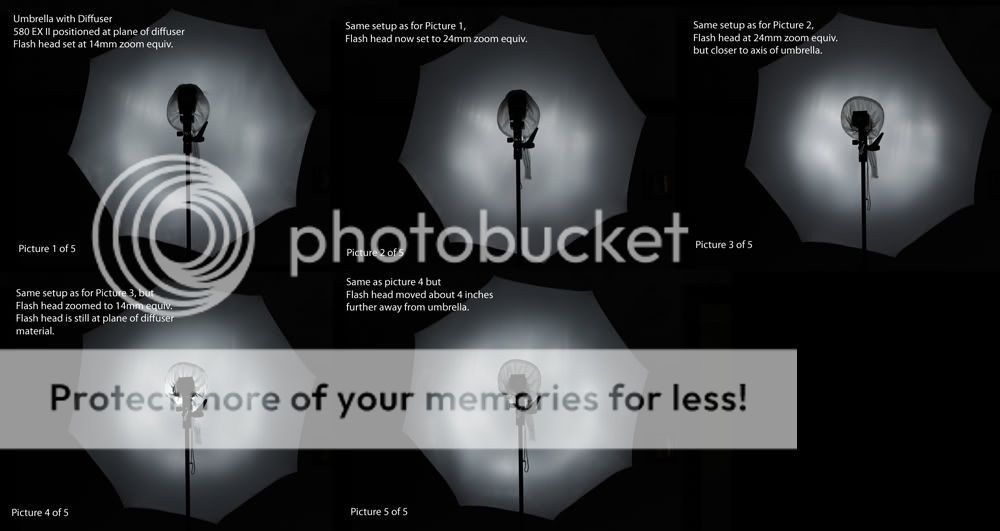pgriz
Been spending a lot of time on here!
- Joined
- Jul 30, 2010
- Messages
- 6,734
- Reaction score
- 3,221
- Location
- Canada
- Can others edit my Photos
- Photos OK to edit
I have a T1i, 580EX II, 430EX II, Yuongo radio triggers, variousumbrellas, stands, etc. As a hobbyist, I am using inexpensive equipment to get the effects I want. Most of my photography with flash is still life, with occasional family portraitures. I set up my light using manual settings on all flashes, and use the radio triggers to fire everything. I use a L358 flash meter to get me close to the ratios I want and then make adjustments from there. So far, so good.
However, when setting up my umbrella(s), I noticed that the evenness of the light depends on where the flash head is in relation to the axis and distance from the umbrella. I also noticed that the flash head setting also seems to affect the distribution of light. Which makes sense, since the umbrellas are really curved surfaces which can have a focal length, and in principle, positioning the flash head at the umbrella’s focal point should allow the light beam reflected to be more or less parallel. Putting the flash head too close will cause the reflected beam to spread, and putting it too far away will cause it to focus at a point closer in.
What I have been finding, is that with one umbrella I’ve been able to find a sweet spot which seems to give even illumination over the entire umbrella. With the others, I can’t find such a ”sweet spot” and the light pattern seen shows hot spots that vary from umbrella to umbrella. Since I’m not the first hobbyist dealing with this, I’m sure someone has already figured out a solution, and that’s what I am looking for.
Probably one recommendation is to get a set of proper lightboxes / softboxes, and perhaps that is where I will need to go if I can’t get the results I want, but I’d like to see if I can get good results with the equipment I already have.
So the question is, is there any procedure or formula that allow me to determine the distance between the flash head and the umbrella, the amount of “off-axis” placement, and the setting of the flash head zoom to get even light?
However, when setting up my umbrella(s), I noticed that the evenness of the light depends on where the flash head is in relation to the axis and distance from the umbrella. I also noticed that the flash head setting also seems to affect the distribution of light. Which makes sense, since the umbrellas are really curved surfaces which can have a focal length, and in principle, positioning the flash head at the umbrella’s focal point should allow the light beam reflected to be more or less parallel. Putting the flash head too close will cause the reflected beam to spread, and putting it too far away will cause it to focus at a point closer in.
What I have been finding, is that with one umbrella I’ve been able to find a sweet spot which seems to give even illumination over the entire umbrella. With the others, I can’t find such a ”sweet spot” and the light pattern seen shows hot spots that vary from umbrella to umbrella. Since I’m not the first hobbyist dealing with this, I’m sure someone has already figured out a solution, and that’s what I am looking for.
Probably one recommendation is to get a set of proper lightboxes / softboxes, and perhaps that is where I will need to go if I can’t get the results I want, but I’d like to see if I can get good results with the equipment I already have.
So the question is, is there any procedure or formula that allow me to determine the distance between the flash head and the umbrella, the amount of “off-axis” placement, and the setting of the flash head zoom to get even light?










![[No title]](/data/xfmg/thumbnail/31/31011-439c1242fe08cf6b54f32bf06523a567.jpg?1734159083)
![[No title]](/data/xfmg/thumbnail/31/31509-b8abaec96e6e375688e269bc89f47652.jpg?1734159970)
![[No title]](/data/xfmg/thumbnail/38/38749-a4ef503184d13a9c7592221cb44ac5e8.jpg?1734172603)

